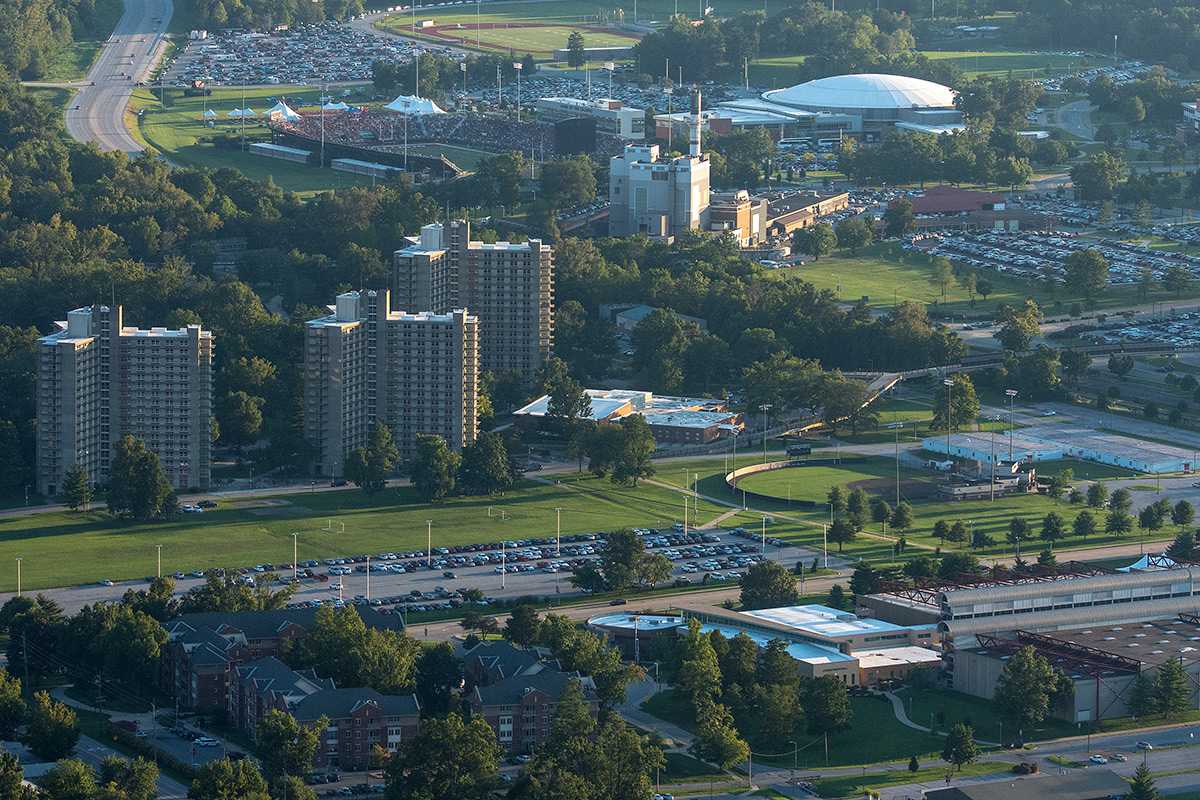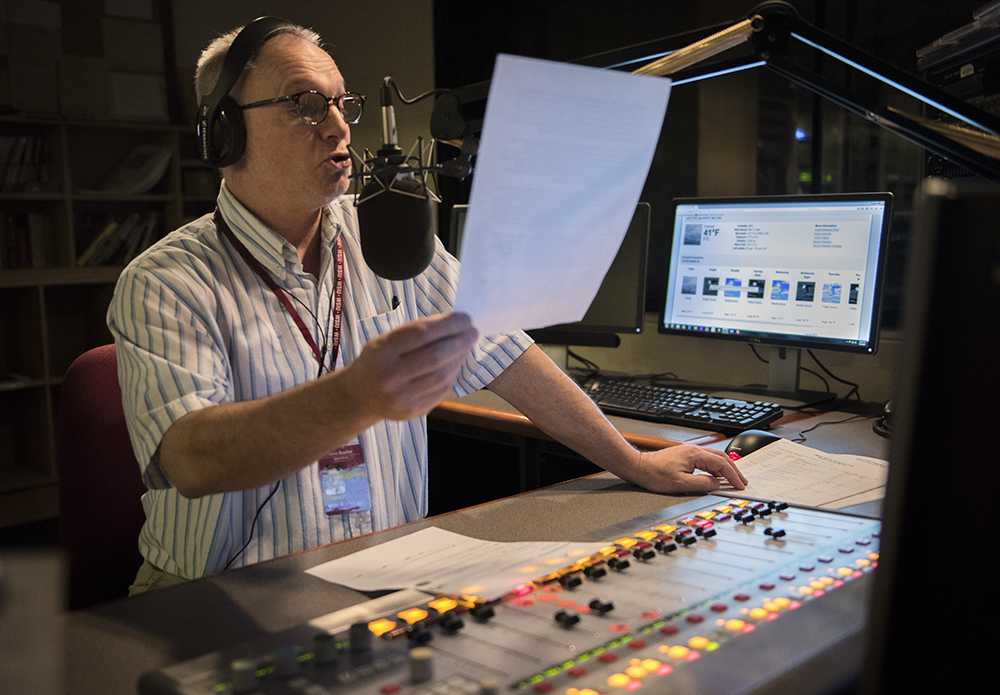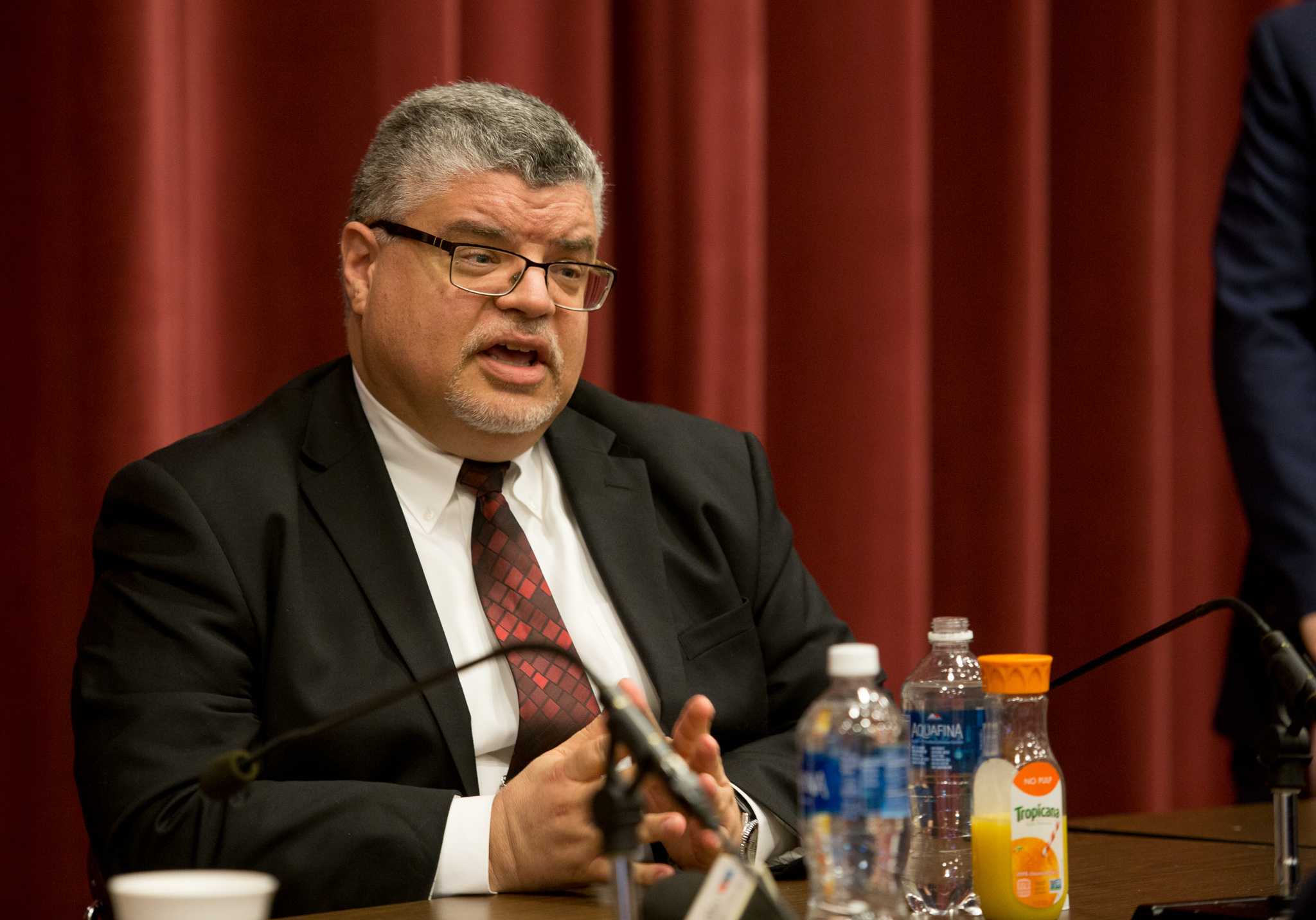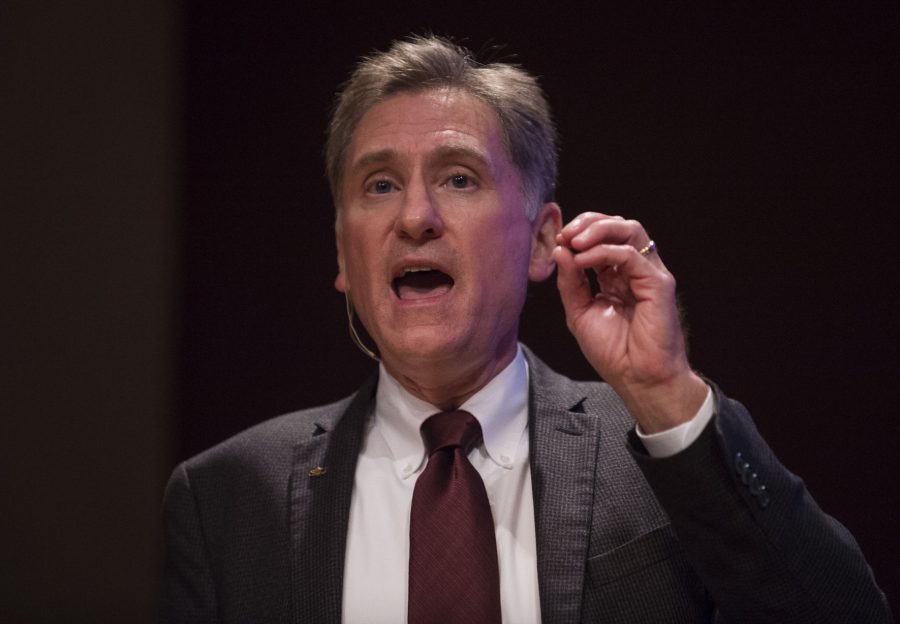SIU president prepares for millions of dollars in potential cuts
SIU President Randy Dunn talks during his State of the System address Monday, Oct. 17, 2016, at the Student Center in Carbondale.
March 22, 2017
SIU President Randy Dunn will soon outline a range of severe cuts the Carbondale campus could be forced to adopt if the state allocates no funding in the foreseeable future.
Dunn said he plans to use the System Connection, the column he emails to faculty and staff, on March 29 to provide the university’s largest campus with a dollar amount it will need to cut if Illinois has no budget by July 1. His announcement will not say what needs to be cut, which is up to campus administration, but rather will lay out a plan for how SIUC can continue to operate without deficit spending.
While he did not know what that amount will be, Dunn said the cuts will be “well into the millions of dollars.”
Advertisement
Dunn said the Carbondale campus would bear the brunt of the next round of cuts, which would be based on a review of the university’s academic and non-instructional units. The School of Medicine and Edwardsville campus would also likely experience more reductions.
Since the state’s budget impasse began in July 2015, the Carbondale campus has reduced $20 million of its approximately $450 million operating budget, Dunn said. That money was saved by making small adjustments, such as reducing positions, not undertaking projects, closing grants and not filling vacancies, the system president said.
But the Carbondale campus can’t keep “undergoing death by a thousand cuts,” Dunn said.
If the university receives no state funding by the end of the legislative session, the Carbondale campus may have to cease operations of administrative units that Dunn said “just won’t be in existence anymore.”
Board involvement
The SIU Board of Trustees might soon intervene with the “pending financial crisis” at the Carbondale campus, Dunn said.
In his upcoming announcement, the president will suggest action for the board to consider regarding Carbondale’s money problems, which Dunn said is contributed to by the budget impasse and the decline in enrollment.
Advertisement*

SIUC has had a structural budget deficit for years, Dunn said, because the university has not reduced the amount of state funding it receives to correspond with its drop in enrollment.
In the last decade, the Carbondale campus has seen a nearly steady decline in students, decreasing from 17,430 students in fall 2006 to 15,987 in fall 2016 — the lowest it has been in more than half a century. Enrollment peaked in fall 1991, when it totaled 24,869, according to university data.
Dunn said the board’s involvement with SIUC’s financial troubles will be discussed during its April 6 meeting in Carbondale.
Potential cuts and possible mergers
After the Illinois Senate’s “grand bargain” to solve the impasse was derailed in early March, representatives of the state’s nine universities were asked to testify in front of the Senate’s higher education committee.
During his testimony, Dunn laid out potential cuts to the university’s three campuses if the state does not pass a budget. If the university is forced to make more cuts, he said, it will use information outlined in the non-instructional program review committee report, which was made public earlier this semester, and a prioritization report on the academic units, which is expected to be sent to the chancellor in May.
In the non-instructional report, the committee identified opportunities for shared services, explored outsourcing and reviewed administrative organizational structures for cost-saving opportunities. It suggested identifying an “appropriate and consistent level of support” for the university’s athletics department and cutting state support from 15 centers or initiatives that the committee said could become self-supporting.
Some of these initiatives include the university’s Center for Fisheries, Aquaculture and Aquatic Sciences, WSIU Public Broadcasting and Counseling and Psychological Services. Directors of a majority of these centers interviewed by the Daily Egyptian have said the cuts outlined in the report would significantly harm their units, and in some cases would lead to their closure.

In his most recent column, Dunn said SIU is back where it was at this time last year when the university considered eliminating 180 faculty and staff members. That proposal would have cut programs and services by nearly $23 million — a measure Dunn described as a “doomsday” list.
In that proposal, officials suggested merging four academic colleges into two, Dunn said. Members of the recent non-instructional program review committee also discussed the possibility of reducing the number of colleges, including the graduate school and the university college.
The committee also recommended combining the admissions processes for undergraduate, graduate and international students.
Dunn has said if SIU is forced into another round of cuts, it will gouge the core of its programs, services, facilities and regional support projects. He said the university faced the same possibility in spring 2016.
But that year, the Legislature passed two stopgap measures that brought $83 million to the SIU system. Those funds, for the most part, were used to pay the bills from the 2016 fiscal year, Dunn has said.
At the university’s School of Medicine in Springfield, another round of cuts would mean examining its telehealth programs, rural healthcare outreach and possibly services provided at the Simmons Cancer Institute, Dunn said. SIUE would also go through another round of cuts.
During the 2015-2016 academic year, the School of Medicine and SIUE went through a comprehensive review process, Dunn said. From those, the School of Medicine reduced costs by $12.5 million and SIUE reduced its budget by 9 percent.
Dunn said the Carbondale campus got an extra year to identify what needed to be cut from its budget because Brad Colwell began as interim chancellor in October 2015. Because the campus was not in an immediate crisis, Dunn said, it made sense to give Colwell time to get acclimated to his new role before being asked to lead the budget review.

Since July 2015, Republican Gov. Bruce Rauner and Democrats who control the state Legislature, including House Speaker Michael Madigan, have failed to come to an agreement on a state spending plan. In light of the budget impasse, public universities are considering ways to continue operations with the assumption some funding could be cut permanently.
While the Senate could still pass its deal, Dunn said he is not highly optimistic about it.
“To some degree, we’re throwing darts at a dartboard with a blindfold on because we don’t know what the state’s going to do,” he said.
Holding its own
None of the university’s three campuses is considering closing, Dunn said.
While the budget crisis has caused concern among faculty and staff, the university is still making payroll. Officials are not considering furlough days at this time, Dunn said.
Compared to public universities across Illinois — particularly smaller ones, such as Eastern, Western, Northeastern, Governors State and Chicago State — SIU benefits financially from being part of a university system, Dunn said.
“If they don’t see state funding come soon, it’s going to be a very, very challenging path ahead for those schools,” he said.
However, dealing with the budget impasse consumes a huge amount of time and takes up “all of the organizational oxygen that exists,” Dunn said.
“It’s very difficult to find capacity to work on other important things for the university when we’re in the middle of this mess,” he said.
Staff writer Luke Nozicka can be reached at 618-536-3325, lnozicka@dailyegyptian.com or on Twitter @lukenozicka.
To stay up to date with all your SIU news, follow the Daily Egyptian on Facebook and Twitter.
Advertisement










Joe Greenberg '89 • Mar 22, 2017 at 1:26 pm
I will not be sending my daughter to my favorite place on the planet. I graduated Southern Illinois University in 1989 with a degree in psychology. I had multiple job offers upon graduation. My education, from my perspective, it was second to none. I was involved in research, active in interscholastic sports activities such as karate and equestrian team ; as well as fraternity life – AEPi. I recall the campus at Southern being simply beautiful. Off-campus housing was nothing to write home about, but my on-campus housing on Thompson point – it really was nice. What I saw today at the University, is a school in need of a serious makeover, education departments being slashed, rampant crime within the Carbondale community, And from my perspective of the loss of social fraternity system – Greek row is gone. It’s boarded up. The strip, the bar scene, the little shops that once lined the road into town – either these are the exact same buildings that were there 30 years, just significantly more rundown, or they’ve been torn down or are vacant. It’s a crime what has become of the school who’s president was once Senator Paul Simon. It’s a crime that education that is so critically needed in southern Illinois be so decimated. And as a parent, I would be negligent, if I were to suggest to my child that this is the school that she should attend for the next four years of her life. And for me this is tragic. Shameful.
Steve • Mar 22, 2017 at 1:13 pm
cannot understand how Gov. Rauner can believe ravaging SIUC and other universities help grow the prosperity of our state. High school grads are heading elsewhere and are not likely to return. Hang in there